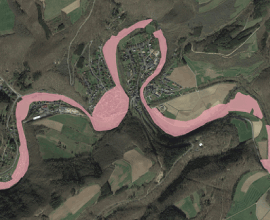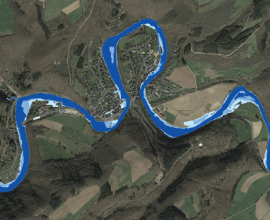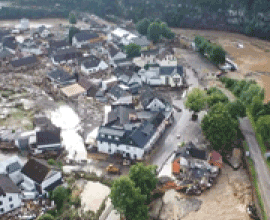On July 13, 2021, a six-day low-pressure weather system brought heavy rainfall to eastern Belgium and western Germany, resulting in some of the worst flooding Europe—and particularly Germany—had seen in decades. In the months following the floods, insured loss estimates for Germany alone increased to an estimated EUR8.5bn.
While devastating, the Bernd floods have taught us the following valuable lessons on flood risk management:
1
Our current analysis of flood risk may not be accurate enough, which can be dangerous, particularly when underestimated.
Processed hydrological data from Bernd clearly shows that the flood risk was underestimated. This would be normally hard to prove, but there were comparable flood events in the same region in 1910 and 1804. If we compare the design flows or official (governmental) flood hazard map, even the most severe (i.e. those with 1-in-1000-year return period) were much smaller than actual extent of the Bernd flooding – see figure below, which shows such extreme return period modelled results that are still substantially less than the Bernd inundation.



Schuld, Germany; Left: Copernicus satellite observation; middle: modelled flood hazard maps up to 1-in-1000-year flood hazard by BfG, right: aerial photograph showing level of damage
2
Flood claims data is invaluable, yet their volume and quality are anything but ideal for accurate risk assessment, and their utilization is limited due to many problems with data security policies.
The claims data emanating from the Bernd flood was not enough to ensure a comprehensive analysis. These data are not just highly important to insurers in terms of designing products and pricing but also for flood risk professionals to reflect their finding in engineering practice. There should be protocol to make their claims data more shareable.
For instance, this event highlighted the importance of the water momentum on loss quantification, a factor that is now reflected velocity in our model to better inform future flood risk modelling.
3
Flood forecasting and flood monitoring systems are improving but need further evolution.
Flood forecasting (through hydrological models) and flood monitoring systems (through observation network and remote sensing) have improved substantially in the past decade, but they are still far from reliable in practice. Local forecasting systems, and the European system (EU-FAS), both issued warnings for the Bernd floods, but were paid insufficient attention mainly due to a low level of trust due to their performance in previous flood events.
Techniques of flood plain determination using satellite imagery proved to be a valuable tool; however, their coverage and their ability to capture peak flow situation, often lasting just minutes, was limited and so must be used with care and understanding of their limitations.
4
Insurance penetration—the protection gap remains too high.
The majority of the damage caused by the Bernd flood event occurred in Germany, in an area with an approximately 45% property insurance penetration. It is obvious a large burden lies on uninsured property owners, as well as local and federal governments. This triggers the need for comprehensive flood analytics, which would provide the base necessary for insurance products to grow with confidence.
Conclusion
History, as well as a generic future prediction of flood regimes, seems to suggest that there is a good chance similar events may happen again. No one knows when, where and at what severity, but it is the goal of our industry to be prepared for such risks.
Find out more
2021 Weather, Climate and Catastrophe Insight investigates how best to build for the long-term while tackling the immediate challenges of a volatile world. Read the report
Find out more about Aon's Catastrophe Insight
About the Author
Petr Punčochář, Ph.D. is responsible for Impact Forecasting’s flood models development managing teams around the globe. He coordinates the development, release and maintenance of the flood model suite and links the R&D work with other parts of the wider IF team, other teams in Aon as well as clients, technical experts and academic partners. He also provides general methodological and technical insights on flood monitoring and analysis, general hydrology, open channel hydraulics, geographical information systems and other related tasks. Petr is an active member of the International Association of Catastrophe Management International and is a member of the Czech delegation of FAO Committee for Mountain Watershed Management.